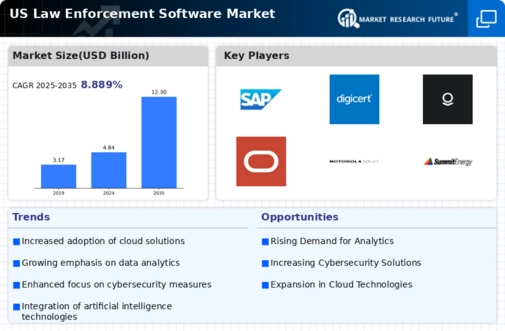The US Law Enforcement Software Market has been experiencing significant growth, fueled by increasing demands for advanced technology solutions within law enforcement agencies. These agencies are under pressure to enhance operational efficiency, improve public safety, and manage crime effectively, which has resulted in a surge of interest in software solutions that cater to their unique needs. The competitive landscape is characterized by both established players and emerging startups focusing on different aspects of law enforcement requirements, such as data management, case management, analytics, and communication tools.
This environment makes it essential for companies to differentiate themselves through innovative features, superior customer service, and strategic partnerships, all while navigating the regulatory and funding challenges inherent in the public sector.In the context of the US Law Enforcement Software Market, SAP stands out with a robust presence that leverages its comprehensive suite of software solutions aimed specifically at public safety and law enforcement. SAP's strength lies in its ability to provide integrated solutions that encompass everything from financial management to operational analytics, which helps law enforcement agencies optimize their processes and make data-driven decisions.
The company has cultivated deep relationships with various government agencies, which enhances its reputation as a trusted partner within the law enforcement community. Furthermore, SAP’s focus on innovation, particularly in data analytics and the development of user-friendly interfaces, has allowed them to maintain a significant competitive advantage. Their ability to adapt to evolving technology trends and the needs of law enforcement agencies only solidifies their stronghold in this marketplace.DigiCert, in the realm of US Law Enforcement Software Market, brings essential cybersecurity solutions that are paramount in today’s digitally driven law enforcement sector.
With its focus on providing secure communications and identity management solutions,
DigiCert offers key products such as SSL/TLS certificates, and digital signatures, vital for protecting sensitive data. The company’s strengths are found in its commitment to security, reliability, and scalability, making it an attractive choice for law enforcement agencies that need to safeguard their information systems. DigiCert has positioned itself effectively within the US market by entering into strategic partnerships and collaborations with other technology providers, thereby enhancing its service offerings.
In recent years, the company has engaged in mergers and acquisitions that have broadened its capabilities, allowing it to address the specific needs of law enforcement while maintaining a competitive edge in an increasingly complex digital landscape.






















Leave a Comment